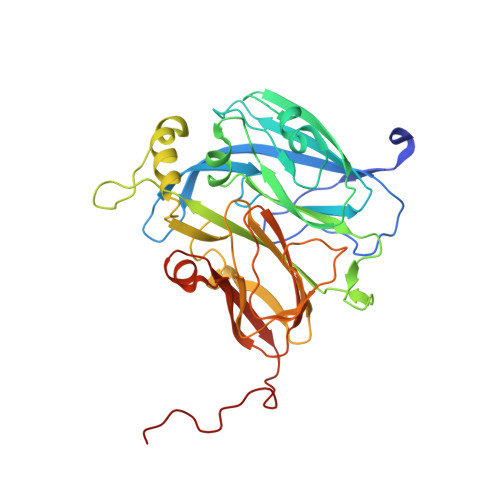Catalytically important damage-free structures of a copper nitrite reductase obtained by femtosecond X-ray laser and room-temperature neutron crystallography.
Halsted, T.P., Yamashita, K., Gopalasingam, C.C., Shenoy, R.T., Hirata, K., Ago, H., Ueno, G., Blakeley, M.P., Eady, R.R., Antonyuk, S.V., Yamamoto, M., Hasnain, S.S.(2019) IUCrJ 6: 761-772
- PubMed: 31316819
- DOI: https://doi.org/10.1107/S2052252519008285
- Primary Citation of Related Structures:
6GSQ, 6GT0, 6GT2, 6GTI, 6GTJ, 6GTK, 6GTL, 6GTN - PubMed Abstract:
Copper-containing nitrite reductases (CuNiRs) that convert NO 2 - to NO via a Cu CAT -His-Cys-Cu ET proton-coupled redox system are of central importance in nitrogen-based energy metabolism. These metalloenzymes, like all redox enzymes, are very susceptible to radiation damage from the intense synchrotron-radiation X-rays that are used to obtain structures at high resolution. Understanding the chemistry that underpins the enzyme mechanisms in these systems requires resolutions of better than 2 Å. Here, for the first time, the damage-free structure of the resting state of one of the most studied CuNiRs was obtained by combining X-ray free-electron laser (XFEL) and neutron crystallography. This represents the first direct comparison of neutron and XFEL structural data for any protein. In addition, damage-free structures of the reduced and nitrite-bound forms have been obtained to high resolution from cryogenically maintained crystals by XFEL crystallography. It is demonstrated that Asp CAT and His CAT are deprotonated in the resting state of CuNiRs at pH values close to the optimum for activity. A bridging neutral water (D 2 O) is positioned with one deuteron directed towards Asp CAT O δ1 and one towards His CAT N ∊2 . The catalytic T2Cu-ligated water (W1) can clearly be modelled as a neutral D 2 O molecule as opposed to D 3 O + or OD - , which have previously been suggested as possible alternatives. The bridging water restricts the movement of the unprotonated Asp CAT and is too distant to form a hydrogen bond to the O atom of the bound nitrite that interacts with Asp CAT . Upon the binding of NO 2 - a proton is transferred from the bridging water to the O δ2 atom of Asp CAT , prompting electron transfer from T1Cu to T2Cu and reducing the catalytic redox centre. This triggers the transfer of a proton from Asp CAT to the bound nitrite, enabling the reaction to proceed.
Organizational Affiliation:
Molecular Biophysics Group, Institute of Integrative Biology, Faculty of Health and Life Sciences, University of Liverpool, Liverpool L69 7ZB, England.



















